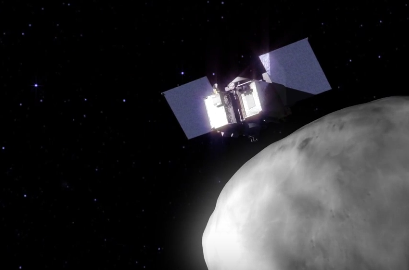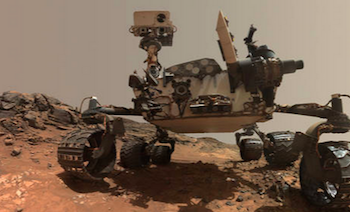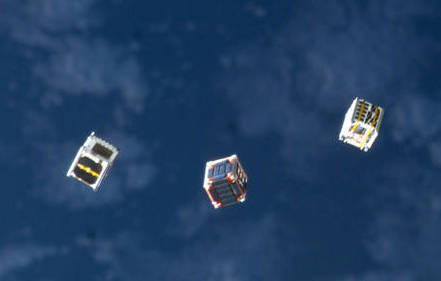4D Printing Allows You To Print Objects That Change Over Time Http://futurism.com/videos/4d-printing-allows-print-objects-change-time/

4D Printing Allows You to Print Objects That Change over Time http://futurism.com/videos/4d-printing-allows-print-objects-change-time/
More Posts from Curiositytherover and Others










this is why we need vaccines (x) | follow @the-future-now
So i was carrying a chemical that was 12 on the pH scale and it fell
I guess you could say I dropped the base

The size of the Orion spacecraft vs Apollo.

Ridiculous History: H-bombs in Space Caused Light Shows, and People Partied. Find out more on HowStuffWorks NOW.


Questioning the reliability of research
This year, one of the top five most talked-about research studies was on the reliability of research findings.
The Reproducibility Project is a vast, multi-institution effort aimed to measure how often researchers could replicate psychology experiments and yield the same result. For the project, 270 academics, including researchers at UC Riverside, UC San Francisco and UC Davis, attempted to replicate the findings from 100 recently published psychology experiments.
They failed twice as often as they succeeded; in fact, only 36 percent of the replicated studies yielded results consistent with earlier findings.
That doesn’t necessarily indicate the original research wasn’t accurate or reliable, researchers say. Many factors, including a lack of detail into methodology, can influence replicability. But the report — published in August in the journal Science — does highlight the challenge of producing reliable findings and suggests that more could be done to enable replicatable results.
Read the other research stories that got the world buzzing in 2015 →

Tesla’s cheapest Model X is priced at $80,000
Solar System: 2016 Preview
What do we have planned for 2016? A return to the king of planets. A survey of mysterious Ceres. More postcards from Pluto. Anyone who follows solar system exploration in 2016 is in for quite a ride. Last year was one for the record books – and now here are 10 things to look forward to in the new year. See also: what we have planned agency wide for 2016.
Juno Arrives at Jupiter

July 4, 2016 is arrival day for the Juno mission, the first sent expressly to study the largest planet in the solar system since our Galileo mission in the 1990s. Humans have been studying Jupiter for hundreds of years, yet many basic questions about the gas world remain: How did it form? What is its internal structure? Exactly how does it generate its vast magnetic field? What can it tell us about the formation of other planets inside and outside our solar system? Beginning in July, we’ll be a little closer to the answers.
OSIRIS-REx Takes Flight

The OSIRIS-REx mission, short for Origins-Spectral Interpretation-Resource Identification-Security-Regolith Explorer, sets sail for an asteroid in September. The spacecraft will use a robotic arm to pluck samples from the asteroid Bennu to help better explain our solar system’s formation and even find clues to how life began.
Dawn Sees Ceres Up Close

After an odyssey of many years and millions of miles, in December the Dawn spacecraft entered its final, lowest mapping orbit around the dwarf planet Ceres. The intriguing world’s odd mountains, craters and salty deposits are ready for their close-ups. We can expect new images of the starkly beautiful surface for months.
Cassini Commences Its Grand Finale

In late 2016, the Cassini spacecraft will begin a daring set of orbits called the Grand Finale, which will be in some ways like a whole new mission. Beginning this year and extending into next, the spacecraft will repeatedly climb high above Saturn’s poles, flying just outside its narrow F ring 20 times. After a last targeted Titan flyby, the spacecraft will then dive between Saturn’s uppermost atmosphere and its innermost ring 22 times. As Cassini plunges past Saturn, the spacecraft will collect rich and valuable information far beyond the mission’s original plan.
New Horizons Sends More Postcards from Pluto

We have stared slack-jawed at the images and discoveries from last year’s Pluto flyby, but the fact is that most of the data that New Horizons collected remains on board the spacecraft. In 2016, we’ll see a steady release of new pictures — and very likely some expanded answers to longstanding questions.
Mars Missions March Forward

With five of our missions continuing their Martian quests, 2016 should be a good year for discoveries on the Red Planet.
Mars Odyssey
Mars Opportunity
Mars Reconnaissance Orbiter
Mars Curiosity
MAVEN
Mercury Transits the Sun

A transit is a very rare astronomical event in which a planet passes across the face of the sun. In May, Mercury will transit the sun, on of only thirteen Mercury transits each century on average.
LRO Keeps an Eagle Eye On the Moon

The Lunar Reconnaissance Orbiter (LRO) will extend its run in 2016, scanning the moon’s surface with its sharp-eyed instruments, investigating everything from lava tube skylights to changes at the Apollo landing sites.
Spacecraft Fly Under Many Flags

Our partner agencies around the world will be flying several new or continuing planetary missions to destinations across the solar system:
Akatsuki at Venus
ExoMars
Mars Express
Mars Orbiter Mission
Rosetta at Comet 67/P
Technology Demonstration Missions Push the Envelope

We’re always looking for new frontiers on distant worlds, as well as the technology that will take us there. This year, several missions are planned to take new ideas for a spin in space:
Deep Space Atomic Clock
NODES
LDSD
Make sure to follow us on Tumblr for your regular dose of space: http://nasa.tumblr.com

Cryovolcanoes: Meet the Frozen Volcanoes on Pluto
Scientists spotted a possible ice volcano on the surface of Pluto. At about 90 miles (150 kilometers) across and 2.5 miles (4 kilometers) high.
Scientists have assembled the highest-resolution color view of one of the cryovolcanoes.
If confirmed, it would be the largest such feature discovered in the outer solar system. More at: http://go.nasa.gov/1mYCtyZ

Contour Crafting’s 3D-Printing Tech Can Build Homes On-Site in Under 24 Hours
Robotic construction system Contour Crafting (CC) has debuted their newest 3D-printing technology that can print entire homes on-site in less than 24 hours. CC’s technology doesn’t just build the architectural structure, it also prints the electrical, plumbing, and air conditioning features mid-construction, with no manual assembly required.
Read more at http://www.futurism.com/toIbI


WATCH: A Tornado of Fire Filmed in Slow Motion (video)
-
 curiositytherover reblogged this · 9 years ago
curiositytherover reblogged this · 9 years ago -
 lesshipsahoy reblogged this · 9 years ago
lesshipsahoy reblogged this · 9 years ago -
 cmoore21033 liked this · 9 years ago
cmoore21033 liked this · 9 years ago -
 andysgra liked this · 9 years ago
andysgra liked this · 9 years ago -
 thoths-foundry-blog reblogged this · 9 years ago
thoths-foundry-blog reblogged this · 9 years ago -
 7563able reblogged this · 9 years ago
7563able reblogged this · 9 years ago -
 7563able liked this · 9 years ago
7563able liked this · 9 years ago -
 410-gone liked this · 9 years ago
410-gone liked this · 9 years ago -
 ceeceyz reblogged this · 9 years ago
ceeceyz reblogged this · 9 years ago -
 thegamejustgotmorefierce reblogged this · 9 years ago
thegamejustgotmorefierce reblogged this · 9 years ago -
 sridkdhar liked this · 9 years ago
sridkdhar liked this · 9 years ago -
 official-arnie-nutts reblogged this · 9 years ago
official-arnie-nutts reblogged this · 9 years ago -
 official-arnie-nutts liked this · 9 years ago
official-arnie-nutts liked this · 9 years ago -
 demonic-flowerchild-blog reblogged this · 9 years ago
demonic-flowerchild-blog reblogged this · 9 years ago -
 demonic-flowerchild-blog liked this · 9 years ago
demonic-flowerchild-blog liked this · 9 years ago -
 jakelist53 liked this · 9 years ago
jakelist53 liked this · 9 years ago -
 juliannabananaa reblogged this · 9 years ago
juliannabananaa reblogged this · 9 years ago -
 ekayah liked this · 9 years ago
ekayah liked this · 9 years ago -
 whiskeykm liked this · 9 years ago
whiskeykm liked this · 9 years ago -
 now-what-where-why liked this · 9 years ago
now-what-where-why liked this · 9 years ago -
 shadowyjellyfishman reblogged this · 9 years ago
shadowyjellyfishman reblogged this · 9 years ago -
 shadowyjellyfishman liked this · 9 years ago
shadowyjellyfishman liked this · 9 years ago -
 acoustichemmingss liked this · 9 years ago
acoustichemmingss liked this · 9 years ago -
 lunar-leviathans reblogged this · 9 years ago
lunar-leviathans reblogged this · 9 years ago -
 lunar-leviathans liked this · 9 years ago
lunar-leviathans liked this · 9 years ago -
 futurismnews reblogged this · 9 years ago
futurismnews reblogged this · 9 years ago